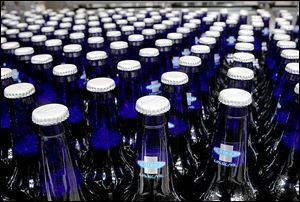
ANHEUSER-BUSCH INBEV
Anheuser-Busch InBev's iconic U.S. brewery still ahead of its rivals
Firm taps into global market
8/10/2013
Bottles of Bud Light Platinum move along during the packaging process at an Anheuser-Busch brewery, where the firm has taken risks with new products.
ST. LOUIS — Five years ago this week, Anheuser-Busch Cos. agreed to be acquired by Belgian brewer InBev, creating the world’s largest brewer and setting off ripples of worry as uncertainty loomed over one of St. Louis’ most revered homegrown businesses.
In the years since the $52 billion deal was announced on July 13, 2008, much has changed at AB’s corporate offices at One Busch Place. The Busch family that ran AB for more than a century would ultimately exit the company whose beers had become iconic symbols of Americana, marking an end of an era.
Now, St. Louis is the North American headquarters for the combined AB InBev, responsible for U.S. and Canadian operations, and the company’s world headquarters is in Belgium.
And cut loose to help pay for the massive merger: Busch Entertainment.
In 2009, AB sold Busch Entertainment’s 10 theme parks, including Busch Gardens and Sea World, to private equity firm Blackstone Group.
But doomsday scenarios of St. Louis losing its place as the epicenter for the company’s U.S. operations failed to materialize. In 2011, AB said it planned to invest more than $1 billion in its U.S. facilities from 2011 to 2014, including upgrades to modernize operations at its St. Louis brewery.
AB InBev remains the largest brewer in the country, with its market share accounting for close to half of all U.S. beer sales. Bud Light remains the best-selling beer in the United States.
This year, the brewer marked the 80th anniversary of its iconic association with Clydesdales, and the company says it’s exploring ways to extend the horses’ visibility internationally.
“There was a tremendous amount of concern that something bad for St. Louis was going to happen, like them closing the brewery or getting rid of the Clydesdales,” said Glenn MacDonald, an economics and strategy professor at Washington University’s Olin Business School. “The fear was that AB would be downsized to oblivion, and that clearly hasn’t happened.”
Mr. MacDonald said some of the changes made after the sale have helped solidify the company’s long-term viability.
“It had the trappings of a family company before, and AB clearly did become a trimmer, more modern company,” Mr. MacDonald said.
After the merger, the combined companies went through an integration period followed by what executives call “optimization.”
One of the changes after the merger included adding elements of Six Sigma — a management philosophy that uses data to cut waste and make improvements — throughout AB, even in human resources.
“It’s a new company,” said Tom Pirko, president of Bevmark, a food and beverage industry consulting firm in Buellton, Calif. “The culture’s changed. The philosophy’s changed. The psychology’s changed. It’s a more disciplined company now and more a philosophy of a global company. We’ve seen a sea change. I hardly recognize it.”
The change in ownership also has made AB less risk-averse, executives say.
Faced with competition from craft beer and lower consumer spending during the economic downturn, AB’s innovation pipeline for new products and packaging has been forced into overdrive.
In 2010, AB added red, white, and blue stars and stripes to Budweiser cans. During the summer months, the packaging has helped spur Budweiser sales, which have been declining each year in the United States since the 1980s.
The year after the red, white, and blue cans made its debut marked “Budweiser’s best summer in the past 10 years,” said Rob McCarthy, vice president of Bud Light brands, who oversaw Budweiser from late 2009 until January.
So far this year, its U.S. product-launches include Beck’s Sapphire, Budweiser Black Crown, Bud Light Lime Straw-Ber-Rita, and Stella Artois Cidre, in addition to the bowtie-shaped Budweiser can.
Those new additions followed the launches of Bud Light Platinum and Bud Light Lime Lime-A-Rita last year, which helped AB InBev’s beer volume in the United States grow in 2012 for the first time in four years.
“The new company is about taking big bets,” said Pat McGauley, who is the vice president of innovation and new products at Anheuser-Busch. “If we believe we have the proper data, we’re willing to make a bet behind it, and I think that differentiates us from our competitors.”
Under Carlos Brito, chief executive officer, AB InBev has set out to grow Budweiser and other brands to a broader worldwide audience. Budweiser volume grew 6.4 percent in 2012, boosted by Latin America and Asia, despite declining sales in the United States.
Last year marked the first time that more than half of Budweiser production sold — 51 percent — was outside of the United States, versus 28 percent in 2009.
AB InBev recently acquired the half of Mexico-based Grupo Modelo it didn’t already own, adding Corona to its stable of “global brands” alongside Budweiser, Stella Artois, and Beck’s. Victor, N.Y.-based Constellation Brands acquired the Corona license and other Grupo Modelo brands in the United States to gain anti-trust approval.